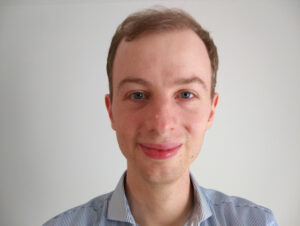
Dr. Pierre Haas · CPTS
Max Planck Institute of Complex Systems, Max Planck Institute of Molecular Cell Biology and Genetics · Dresden, Germany
Biography
Pierre Haas is an applied mathematician from Luxembourg. After his undergraduate studies at Cambridge, at the end of which he was awarded the Mayhew Prize, he stayed in Cambridge for his doctoral work under the supervision of Prof. Raymond E. Goldstein FRS, in the Department of Applied Mathematics and Theoretical Physics. He submitted his thesis on the “Mathematics of Morphogenesis: Inversion in Volvox and Other Questions of Shape” in 2016; this was awarded the American Physical Society’s Award for Outstanding Doctoral Thesis Research in Biological Physics in 2017.
He failed to leave Cambridge once again, his research was first funded by an EPSRC Doctoral Prize Fellowship and then an independent Nevile Research Fellowship at Magdalene College. In 2020, he moved to the “Other Place” (the University of Oxford), to take up a Hooke Research Fellowship at the Mathematical Institute, and a Senior Demyship at Magdalen College.
From January 2021, he will lead the interdisciplinary Max Planck Research Group “Self-Organization of Multicellular Systems” at the Max Planck Institutes for the Physics of Complex Systems and of Molecular Cell Biology and Genetics, based at the Center for Systems Biology in Dresden.
Education and positions held
- From 2021:
- Max Planck Research Group Leader, MPI-PKS and MPI-CBG and CSBD
- 2020-2021:
- Hooke Research Fellow, Mathematical Institute, University of Oxford
and Senior Demy, Magdalen College, University of Oxford
- Hooke Research Fellow, Mathematical Institute, University of Oxford
- 2017-2020:
- Nevile Research Fellow in Applied Mathematics, Magdalene College
and Department of Applied Mathematics and Theoretical Physics, University of Cambridge
- Nevile Research Fellow in Applied Mathematics, Magdalene College
- 2016-2017:
- EPSRC Doctoral Prize Fellow, Department of Applied Mathematics and Theoretical Physics, University of Cambridge (Supervisor: Prof. Raymond E. Goldstein FRS)
- 2013-2016:
- PhD in Applied Mathematics, Department of Applied Mathematics and Theoretical Physics, University of Cambridge (Supervisor: Prof. Raymond E. Goldstein FRS
- 2009-2013:
- BA & MMath, Gonville & Caius College, University of Cambridge
Research Summary
I am a theoretical biophysicist. Much of my research has focused on the mechanics of developmental biology.
A longstanding research interest of mine is the inversion process during which the embryos of the green alga Volvox turn themselves inside out. This simple process shares features with the development of higher organisms and is a simple model for cell sheet folding mechanics. In close collaboration with experimentalists, I have derived a quantitative elastic theory for inversion that explains the mechanical basis for the arrest of inversion in mutants and chemically treated embryos.
More recently, my work has focused on a more general problem in the continuum mechanics of cell sheets: what are the nonlinear constitutive laws for large deformations of biological tissues? I have shown how the continuum limit of discrete cell sheet models differs from classical nonlinear elasticity by additional, nonlocal and nonelastic terms. Moreover, I have extended the classical shell theories of elasticity to include the large bending deformations that abound in development.
Questions for future research that my group will explore in collaboration with experimental groups include:
(1) How is robust development possible despite large amounts of biological variability and mechanical constraints?
(2) What are the continuum theories that describe biological tissues and the processes of cell migration and cell intercalation that they undergo during development?
Key publications
- P. A. Haas and R. E. Goldstein, “Morphoelasticity of Large Bending Deformations of Cell Sheets during Development”, arXiv:2007.07126 (sub judice, 2020)
- P. A. Haas and R. E. Goldstein, “Nonlinear and Nonlocal Elasticity in Coarse-Grained Differential-Tension Models of Epithelia”, Physical Review E 99, 022411 (2019)
- P. A. Haas and R. E. Goldstein, “Embryonic Inversion in Volvox carteri: The Flipping and Peeling of Elastic Lips”, Physical Review E 98, 052415 (2018)
- P. A. Haas, S. S. M. H. Höhn, A. R. Honerkamp-Smith, J. B. Kirkegaard, and R. E. Goldstein, “The noisy basis of morphogenesis: Mechanisms and Mechanics of Cell Sheet Folding Inferred from Developmental Variability”, PLoS Biology 16, e2005536 (2018)
- S. Höhn, A. R. Honerkamp-Smith, P. A. Haas, P. Khuc Trong, and R. E. Goldstein, “Dynamics of a Volvox Embryo Turning Itself Inside Out”, Physical Review Letters 114, 178101 (2015)
